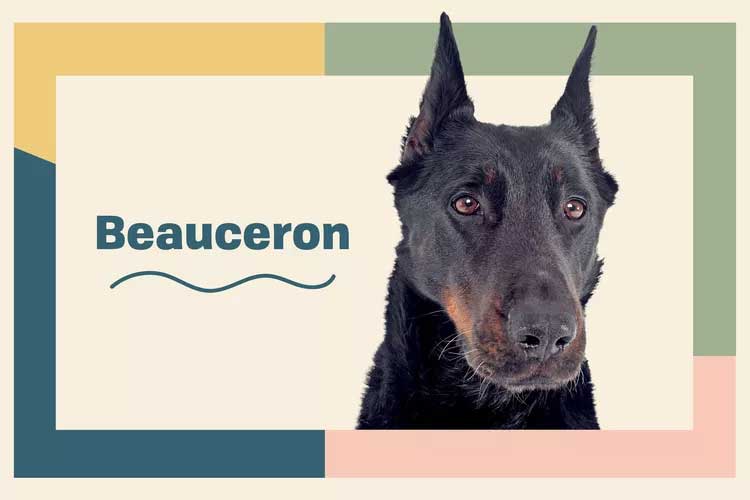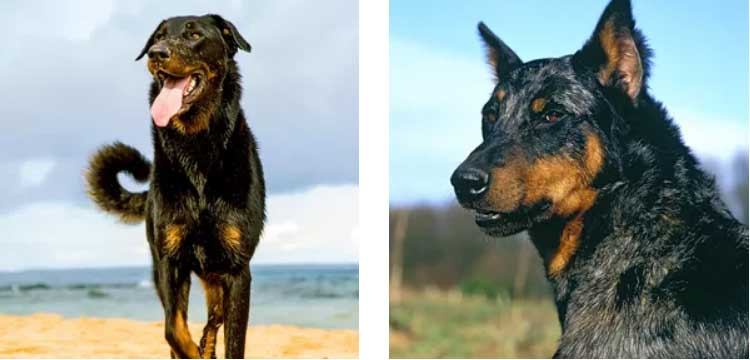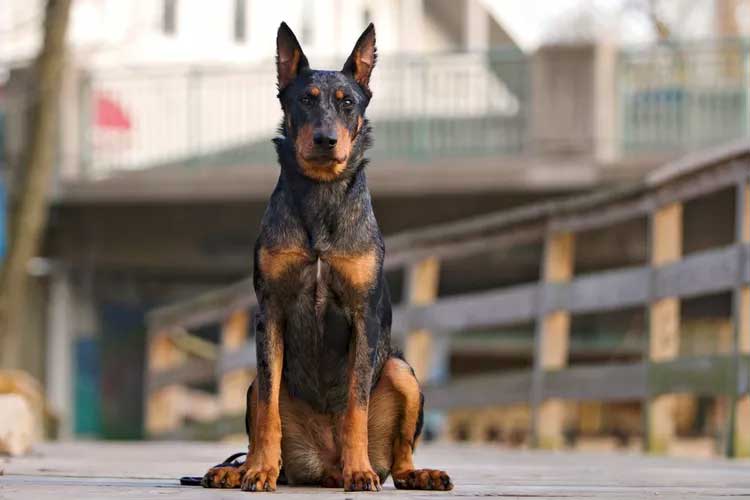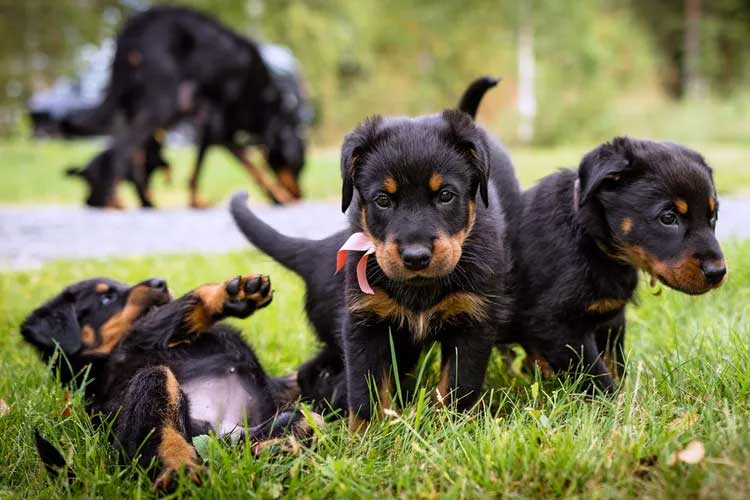As the largest French herding breed, the "Beauce" is a very active, extremely intelligent, and versatile sheep herder, working partner, and loving companion.

Beauceron Overview
| OFFICIAL NAME | Beauceron |
| COMMON NAME | Beauceron |
| PET HEIGHT | 24 to 28 inches |
| PET WEIGHT | 70 to 110 pounds |
| LIFESPAN | 10 to 12 years |
| GOOD WITH | families |
| TEMPERAMENT | aloof, outgoing, playful |
| INTELLIGENCE | high |
| SHEDDING AMOUNT | frequent |
| EXERCISE NEEDS | high |
| ENERGY LEVEL | active |
| VOCAL LEVEL | when necessary |
| DROOL AMOUNT | low |
| BREED GROUP | herding |
| BREED SIZE | large (61-100 lbs.) |
| COAT LENGTH | short |
| COLORS | black |
| PATTERNS | black and tan, harlequin |
| OTHER TRAITS | easy to train, good hiking companion, strong loyalty tendencies |
Beaucerons are truly a singular breed that requires an equally remarkable and atypical owner. The Beauceron—also known as Berger de Beauce ("sheepdog from Beauce"), Bas Rouge (red-stockings), or just "Beauce" for short—is a dignified, intelligent, and highly athletic breed. These statuesque dogs are the largest of the French sheepdogs and were originally bred to tend large flocks of sheep in northwestern France, specifically the region of Beauce, from which their name comes. The breed served valiantly in both World Wars, acting as messengers, mine and bomb detection dogs, and guardsmen.
In the U.S., the breed remains rare and is not likely to be seen at local dog parks. Because of their smarts and uncanny ability to work alongside their handler, they're often employed in the military or police force and can be seen working in bomb detection, tracking, scent detection, and search and rescue.
The Beauceron's intelligence to be wonderfully intense, and their energy makes them an ideal working dog well-suited to a versatile lifestyle. However, those traits make them unsuitable for first-time dog owners or families that can't devote time every.single.day to significant physical and mental stimulation Beauces crave.
Appearance
Sleek but also thick and muscular, the Beauceron grabs everyone's attention when he walks by. Weighing in at 70–110 pounds and with an average height of 25–28 inches for males and 24–27 inches for females, these are big dogs.The Beauceron's coloring is well-balanced and they're commonly seen wearing their black and "squirrel red" tuxedo. But they can also be found in shades of gray-black with tan and even harlequin (patches of black and blue-gray). Their coats are mostly short, but the neck and back legs have areas of fringe and thickness that can be over 1 inch long.

The Beauce tail is long and thick, curving into a slight j-shape and complimenting their streamlined appearance. Their large, long heads have ears that may be naturally set, hanging loose, or cropped. Note that cropping practices are controversial: As the American Veterinary Medical Association says, crops are typically done for cosmetic reasons and have no proven health benefits. They can also be painful for the pup.
Like any herding breed, these dogs do shed and seasonal shedding can be significant, requiring owners to brush their Beauce daily. And just like all breeds, the Beauceron needs bi-weekly nail trims to keep their paws and joints healthy. They also require monthly trims of their double dewclaws, a unique breed trait that really stands out to unsuspecting strangers.
Temperament
The Beauceron's intelligence is a standout feature, making them an eager and enjoyable learner. Want to teach them basic skills? Easy. Want to teach them advanced skills? No problem. These dogs can learn it all, which makes them desirable for people interested in competitive dog activities, such as obedience and rally, agility, herding, scent work, and more. But their smarts combined with their energy make them only suited to a special owner; they need someone who doesn't enjoy personal space, can throw a Frisbee all day long, and doesn't like taking long naps or enjoying alone time.With a long history of breeding dedicated to herding massive flocks of sheep, the Beauceron has a keen, watchful eye that can detect and follow quick movements. This means that the fast and erratic locomotion of little critters and children may entice intense games of chase. The Beauceron may also not appreciate an unfamiliar neighbor or unsuspecting animal coming into their yard. They are quickly bonded to their human parents and are dedicated to their families.

Beaucerons are not happy to stay inside all day or be confined to a kennel. They prefer to be with their humans and want to enjoy your day-to-day activities alongside you! They require significant time and attention spent on physical and mental exercise, so Beauces do best in homes with active owners. These dogs need daily walks, runs, or hikes, ample chances to stretch their legs and use their instinctual abilities to smell, chase, and catch. An experienced Beauceron owner will enroll their dog in positive reinforcement-based training classes, starting right away with puppy kindergarten and continuing into adulthood, enabling them to learn all sorts of useful skills, socialize with other dogs and pups, and meet new people.
After a good day full of enrichment opportunities and time with their loved ones, Beaucerons can be happy on the couch, enjoying movie time alongside you. When introduced to small pets like cats or birds, or to your kiddos, during puppyhood, they're amiable and affectionate siblings.
Living Needs
If you are looking for (and prepared for) a true athlete with an uncanny ability to focus on the task at hand, the Beauceron is an excellent competition partner. But, if you are not prepared or well-researched on their ability to jump over short fences, chase local wildlife, or run at high speeds, these dogs will cause some panic at no fault of their own. They do best when they have access to a large yard with six-foot fencing where they can run freely, and long hikes where they can sniff and investigate the world around them. Daily long walks are a must. And because they are muscular and strong, teaching them to walk nicely with a comfortable body harness and leash is a must.A versatile breed, these dogs do well in most climates, but their black coats heat them up under the sun. Some Beaucerons enjoy a good swim or romp in the snow, and then need a comfy place to rest near their family members. They want to be wherever you are and they will not be happy to be left at home alone all day long. The Beauceron is devoted and very attached to his family—which makes him lonely when you are away and eager to be your favorite travel companion.
Whether it's in the form of herding, competitive obedience, agility, scent work and tracking, disc dog, or flyball, these dogs want—and need—jobs and activities. Beaucerons excel in careers that range from sheep herder to search-and-rescue hero. They need daily opportunities to show off their brain power and excel at learning skills and tricks in a safe environment, but they are also sensitive and quick to experience overarousal.

"These dogs are talented at many jobs, but they prefer consistency and may not enjoy the loud and chaotic environments that come with the territory in public places," says Brenda Wendt, a professional dog trainer, conservation detection dog handler for West EcoSystems, and previous Beauceron owner. "They want to be with you, but don't expect them to want to come to summer festivals or the dog park—it's too overwhelming for an intense Beauceron."
The Beauceron can make a wonderful addition to a family and a loveable sibling to other dogs, cats, and small children when they are provided consistent socialization opportunities. But because they have a long history as herding and working dogs, they are likely to find fast movements enticing, so potential owners should be prepared to monitor their interactions with kids and small animals.
Care
Weighing in at 70–110 pounds and an average height of 25–28 inches for males and 24–27 inches for females, these are big, spirited, and intensely smart dogs. Although these features make them adaptable, they are not well-suited to first-time dog owners.These dogs make grooming easy peasy … except for their nails. The Beauceron is one of only a few breeds that have double dewclaws. Some believe that the function of double dewclaws is to aid the dog in stability, making activities like herding more efficient. Nowadays, and particularly in the U.S., it's uncommon to see puppies left with their dewclaws, as they are typically removed shortly after puppies are born. However, the practice of removing them is becoming increasingly more controversial, and breeders of Beaucerons do not remove them as they are much longer, and thicker, than normal "dews," and are also a breed standard. Beaucerons need to have their nails trimmed regularly, as well as their dewclaws.

Like all herding breeds, the Beauceron sheds. Quite a bit. Seasonal shedding can be pretty intense, and your Beauce will need to be brushed weekly, even daily, during high-shed times in spring and fall. Their coats are short and thick, making them easy to bathe and to de-stink after a super fun but dirty hike or swim. But your Beauceron will need regular brushing and dematting under the belly to make sure your dog is always looking, and feeling, their best.
The Beauceron does best with high-quality dog food, whether commercially manufactured or home-prepared with your veterinarian's guidance. The Beauce should be fed according to their age and current weight and careful attention should be given to fast-growing Beauceron puppies, who may need additional calories during rapid-growth phases. Beaucerons that spend their days working alongside devoted owners may require additional nutrition or supplements to ensure the proper growth, development, and maintenance of their bones and joints.
These dogs won't remain happy if they are only offered a short walk around the block each day. They require daily opportunities to use their natural abilities to sniff, herd, and chase. Providing them a regular schedule that includes an enrichment routine is crucial to their health and wellbeing.
"The Beauceron is extremely devoted to their family, but that devotion also translates into a need for a strict routine and that can be a problem if you want to travel or expect you can just leave them with a family member or friend," Wendt says. "They can become very stressed and anxious when you change up their environment."
Health
The Beauceron is a healthy breed with an average lifespan of 10–12 years. They enjoy being active and need lots of good exercise to keep them trim and fit. The Beauce needs a loving owner that will provide them access to quality exercise and activities like hiking, running, fetch and Frisbee, and long walks every day.Beauces, as with any large or deep-chested dog may be susceptible to bloat, a sudden and life-threatening stomach condition. Beauceron owners should educate themselves on what symptoms to look for and talk to their veterinarian about ways to prevent this scary issue.
Like so many other breeds, Beauces can be susceptible to hip dysplasia, and when purchasing a Beauceron puppy it's important to ensure the breeder provides information on recent OFA testing that includes checks for heart, eye, and thyroid disease. In addition to these tests, the American Beauceron Club also recommends elbow OFA testing and that prospective Beauceron owners discuss osteochondrosis Dessicans (OCD), an orthopedic disease most commonly seen in rapidly growing large and giant breed dogs, with their vet.
As with all breeds, a Beauceron's ears should be checked regularly to make sure they are clean and healthy, and the teeth should be brushed often.

History
A French herding breed originating in Beauce, the Beauceron has a long history as a sheepherder and working companion and was solely developed in France. They're a rare breed outside of France and are the largest, and one of the oldest, French breeds.Developed originally to be a multipurpose dog, by the early 1800s the Beauceron became popular for driving cattle and sheep across the plains of La Beauce alongside their "cousin" breed, the briard. Their first recognized public appearance as an established breed was in 1863 at the Universal Exposition in Paris. As their breeding became more popular and widespread, they were recognized by the Societe Central Canine in 1893 as the Berger de Beauce, and eventually in 1922 the breed club, Club des Amis Du Beauceron, was founded.
The French army began to utilize the Beauceron and the breed became a hero during both World Wars, excelling as a bomb detection dog and messenger. Beaucerons were also trained for scent detection and sniffing out mines. Today, Beaucerons are still used as military dogs as well as police dogs.
The American Kennel Club did not officially recognize the Beauceron until 2007, and they remain one of the AKC's rarest breeds, ranking as the 156th (out of 197) most popular breed.

Fun Facts
In the 2009 movie Hotel for Dogs starring Emma Roberts, the dog Henry is a Beauceron.In 2008, the Beauceron made its debut at the Westminster Kennel Club Dog Show.
A Beauceron named Cara (her official name was O'Cara Bleue de St Sacrement) was among the dogs used for search and rescue at the site of the World Trade Center tragedy in 2001. She reportedly wore a special camera around her neck that enabled humans to see into crevices where only dogs could reach. She received an award for her work at the AKC Classic in Orlando in December 2001 and at the Westminster Kennel Club dog show in New York City in February 2002.